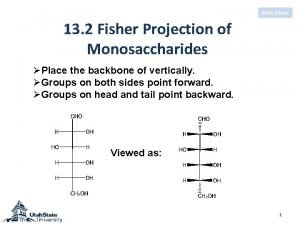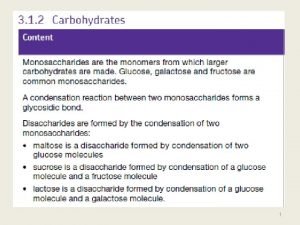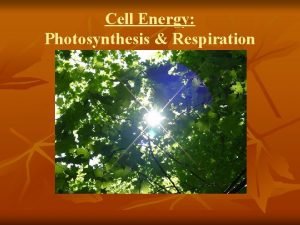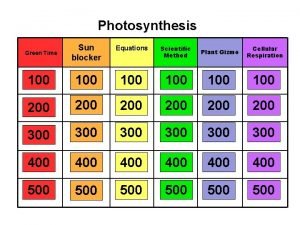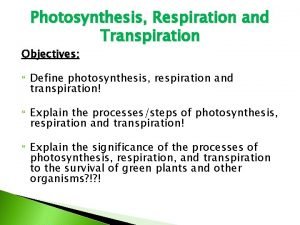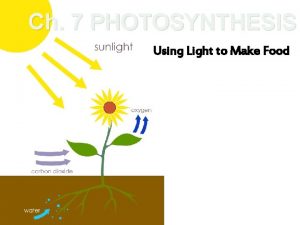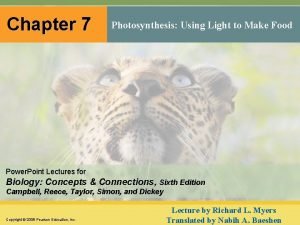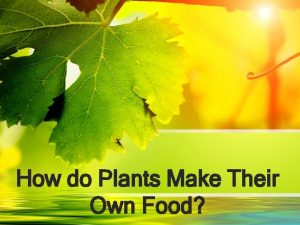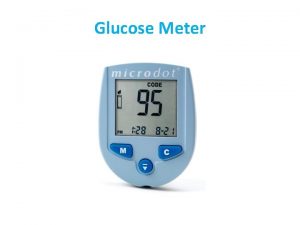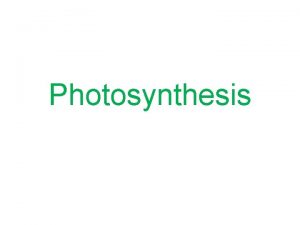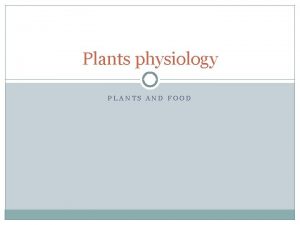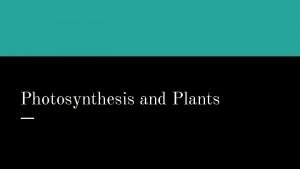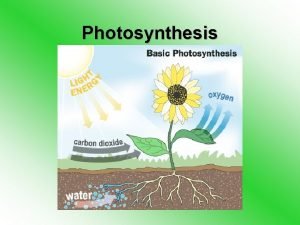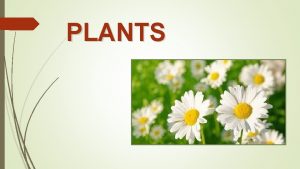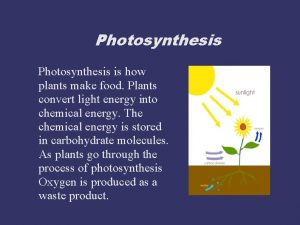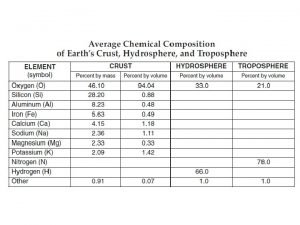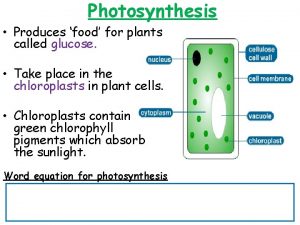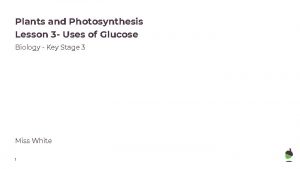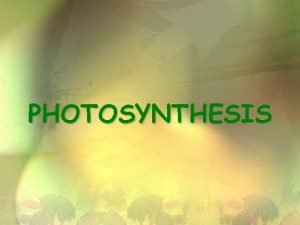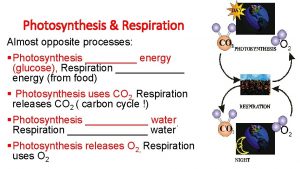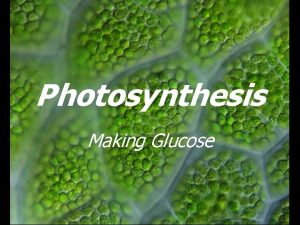Photosynthesis How plants make glucose molecules Photosynthesis the















































- Slides: 47


Photosynthesis: How plants make glucose molecules…

Photosynthesis • the process of creating chemical energy from solar energy (sunlight) • Stores energy in the bonds of sugar (glucose) • occurs in all producers/plants/autotrophs • takes place in the chloroplasts • uses chlorophyll, a green pigment


Organisms get the organic nutrients they need in two basic ways: 1. Autotrophs are organisms that are capable of synthesizing organic nutrients from simple inorganic substances (e. g. , green plants & algae) 2. Heterotrophs are organisms that cannot synthesize their own organic nutrients (e. g. , animals)


Photosynthesis occurs in chloroplasts

Parts of the Chloroplast: 1. Grana – stacks of thylakoids • Chlorophyll is located here • Light – Dependant reactions occur here (LIGHT rxns. ) 2. Thylakoids – flattened sacs of photosynthetic membranes that make up the grana 3. Stroma – region surrounding grana • Light – Independent reactions occur here (DARK rxns)


A word about pigments… • Pigments are chemical compounds which reflect only certain wavelengths of visible light • This makes them appear “colorful” • They also absorb certain wavelengths of light which we cannot see • Several pigments are embedded into the membranes of the chloroplast

• Chlorophyll A is the most important photosynthetic pigment • Other pigments are present in the leaf: – Chlorophyll B (yellow & green) – Carotenoids (orange & red) – Xanthophylls (yellow & brown)

• Chlorophyll A looks green because it reflects green light, and absorbs red and blue light • the energy from the red and blue light is absorbed and used for photosynthesis • the green light we see is reflected from the plant and cannot be used to do photosynthesis.

Electromagnetic Spectrum:

…so the solar energy called “visible light” Creates energy for photosynthesis to occur





Photosynthesis Equation: 6 H 2 O + 6 CO 2 -----sunlight------> C 6 H 12 O 6+ 6 O 2




Parts of the leaf to know: 1. Upper epidermis – single layer of cells containing few or no chloroplasts; covered by cuticle 2. Cuticle – waxy covering of leaf 3. Palisades layer – elongated cells in the leaf where photosynthesis occurs 4. Spongy layer – loosely packed, irregular cells; temporary storage of sugars & amino acids

5. Stomates – openings in the epidermis of leaves that allow the exchange of respiratory gases 6. Guard cells – regulate water loss through stomates 7. Xylem – transports water throughout the leaf 8. Phloem – food storage in the leaf 9. Spongy mesophyll – below the palisades layer; filled with cells with air spaces between them


Stoma






Photosynthesis involves 2 reactions: 1. The light-dependent reaction (needs light) 2. The light-independent reaction (does not need light)



2 reactions in Photosynthesis: 1. The light-dependent reaction happens in the thylakoid membrane and converts light energy to chemical energy Water (H 2 O) enters the thylakoid and oxygen (O 2) is given off

• The energy obtained in the light reaction is stored in a chemical called ATP (adenosine triphosphate), a compound used by cells for energy storage



2. The light-independent reaction takes place in the stroma within the chloroplast CO 2 is converted to glucose This rxn does not need light to occur But it does need the products of the light rxn (ATP & electron carriers) to produce the glucose These rxns are also called the Calvin Cycle







Thanks for the glucose!!

 Green plants make their own food by photosynthesis
Green plants make their own food by photosynthesis What raw materials does a plant need for photosynthesis
What raw materials does a plant need for photosynthesis Merits and demerits of glucose oxidase test
Merits and demerits of glucose oxidase test D-allose fischer projection
D-allose fischer projection Csf glucose vs blood glucose
Csf glucose vs blood glucose Alpha glucose and beta glucose difference
Alpha glucose and beta glucose difference Organic molecules vs inorganic molecules
Organic molecules vs inorganic molecules Chapter 6 cell energy photosynthesis and respiration
Chapter 6 cell energy photosynthesis and respiration The food that plants produce during photosynthesis is
The food that plants produce during photosynthesis is Photosynthesis definition
Photosynthesis definition Non vascular plants
Non vascular plants Classify the non flowering plants with examples
Classify the non flowering plants with examples C3 plants vs c4 plants
C3 plants vs c4 plants Vascular plants
Vascular plants Photosynthesis using light to make food
Photosynthesis using light to make food The process of photosynthesis
The process of photosynthesis What food do plants make
What food do plants make Natural source of nitrogen
Natural source of nitrogen Chloroplast function
Chloroplast function Go make a difference
Go make a difference Make the lie big, make it simple
Make the lie big, make it simple Make the lie big keep it simple
Make the lie big keep it simple Một số thể thơ truyền thống
Một số thể thơ truyền thống Trời xanh đây là của chúng ta thể thơ
Trời xanh đây là của chúng ta thể thơ Frameset trong html5
Frameset trong html5 Số nguyên tố là số gì
Số nguyên tố là số gì đặc điểm cơ thể của người tối cổ
đặc điểm cơ thể của người tối cổ Phối cảnh
Phối cảnh Các châu lục và đại dương trên thế giới
Các châu lục và đại dương trên thế giới Chụp phim tư thế worms-breton
Chụp phim tư thế worms-breton Thế nào là hệ số cao nhất
Thế nào là hệ số cao nhất ưu thế lai là gì
ưu thế lai là gì Sơ đồ cơ thể người
Sơ đồ cơ thể người Tư thế ngồi viết
Tư thế ngồi viết Cái miệng xinh xinh thế chỉ nói điều hay thôi
Cái miệng xinh xinh thế chỉ nói điều hay thôi Mật thư tọa độ 5x5
Mật thư tọa độ 5x5 Bổ thể
Bổ thể Tư thế ngồi viết
Tư thế ngồi viết Thẻ vin
Thẻ vin Thơ thất ngôn tứ tuyệt đường luật
Thơ thất ngôn tứ tuyệt đường luật Chúa yêu trần thế alleluia
Chúa yêu trần thế alleluia Các châu lục và đại dương trên thế giới
Các châu lục và đại dương trên thế giới Hổ đẻ mỗi lứa mấy con
Hổ đẻ mỗi lứa mấy con Từ ngữ thể hiện lòng nhân hậu
Từ ngữ thể hiện lòng nhân hậu Diễn thế sinh thái là
Diễn thế sinh thái là Vẽ hình chiếu vuông góc của vật thể sau
Vẽ hình chiếu vuông góc của vật thể sau V. c c
V. c c Phép trừ bù
Phép trừ bù



